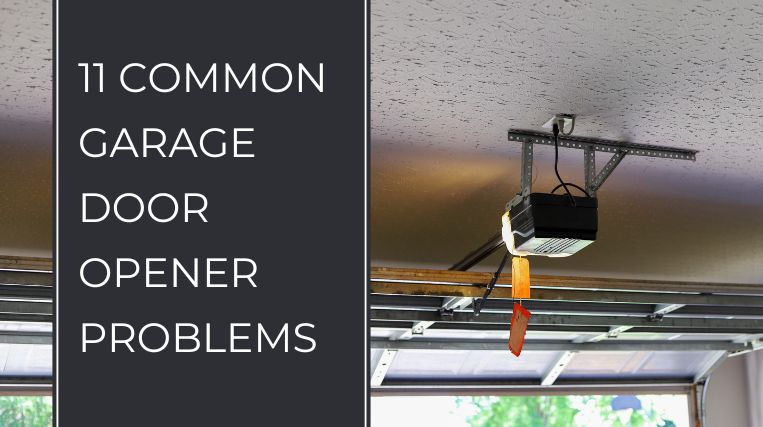A malfunctioning garage door opener that refuses to open or close can be extremely frustrating. Garage door openers contain mechanical and electrical parts that can wear out over time and cause problems.
This guide outlines 11 of the most common issues with garage openers, including problems with the opener motor, sensors, remote, and more.
We have also provided tips on diagnosing each issue and recommendations for DIY and professional repairs to help get your garage door functioning properly again.
Table of Contents
Common Garage Door Opener Problems
Garage door openers contain many mechanical and electrical components that can malfunction over time, leading to operational issues. We have mentioned 11 of the most common garage opener problems below.
1. Garage Door Opener Not Responding to Remote Control
The garage door opener may not respond to the remote control for several reasons. Firstly, check if the remote’s batteries are depleted, as this is a common cause. Additionally, ensure no obstructions block the signal path between the remote and the opener.
Verify that the remote is within the designated operating range to establish a successful connection.
2. Loud or Noisy Garage Door Opener
The loud or noisy garage door opener is typically attributed to insufficient lubrication on moving components such as the chain or belt. Over time, friction between these parts increases, leading to heightened noise levels during operation.
For more details on the reasons behind noisy garage doors, check out this in-depth post covering the key causes and solutions for noisy garage door openers and hardware in Reasons for Noisy Garage Door.
Regular application of appropriate lubricants helps reduce friction, resulting in a quieter and smoother functioning garage door opener.
3. Garage Door Not Closing Completely
The garage door not closing completely may be attributed to issues with the close limit switch on the garage door opener. This switch determines how far the door needs to move before signalling the opener to stop.
If the close limit switch is misadjusted, the door may stop prematurely, leaving a gap.
Regularly inspecting and adjusting the close limit switch ensures proper alignment between the garage door and the opener, allowing for complete and secure closure.
4. Garage Door Reverses Before Closing
The garage door reversing before closing is commonly associated with a malfunction in the safety sensor system, a crucial component of the garage door opener.
When the safety sensors detect an obstruction in the door’s path, they trigger an automatic reversal to prevent potential damage or accidents.
This safety feature is integral to the garage door opener’s functionality, ensuring the door responds appropriately to potential hazards in its trajectory.
If the safety sensors are misaligned or obstructed, the garage door opener interprets this as a safety risk, causing the automatic reversal before completing the closing cycle.
5. Garage Door Opener Remote Intermittently Working
The garage door opener remote may intermittently work due to interference from other devices operating on similar frequencies. This interference can disrupt the remote and garage door opener communication, leading to inconsistent performance.
To resolve this issue, it’s essential to identify and eliminate potential sources of interference, ensuring a reliable connection between the remote and the garage door opener.
6. Slow Opening or Closing Speed
Slow opening or closing speed in a garage door is typically related to the garage door opener’s motor. The speed of the opener is influenced by factors such as the motor’s power and the condition of its moving components, like belts or chains.
If the opener’s motor is experiencing issues, it can decrease the door’s operational speed. Regular maintenance, including lubricating moving parts and ensuring the motor is in good condition, can help maintain optimal opening and closing speeds.
7. The Garage Door Opener Motor is Running but the Door is Not Moving
The issue of the garage door opener motor running but the door not moving is commonly associated with a disengaged trolley mechanism. This occurs when the attachment between the trolley and the opener carriage becomes disconnected.
The trolley, responsible for moving the door along the track, must be adequately engaged with the opener carriage to ensure coordinated operation.
If the trolley is disengaged, even though the motor is running, the door will not respond, highlighting the critical role of the trolley mechanism in the overall functionality of the garage door opener.
8. Garage Door Opener Light Not Working
The garage door opener light may not work due to a faulty light bulb or a malfunctioning light socket within the door opener unit. The light in a garage door opener is an integrated component designed to illuminate the garage space.
If the light bulb is burned or the socket is damaged, the garage door opener light cannot function correctly.
Regular inspection and replacement of the light bulb or socket, as specified in the opener’s manual, are essential for maintaining the proper operation of this component.
9. Inconsistent Response to Wall Switch
The inconsistent response to the wall switch may be attributed to wiring issues or a malfunctioning wall switch component.
This is directly related to the garage door opener, as the wall switch is a primary control interface for operating the opener. Problems such as loose connections or a faulty wall switch can disrupt the communication between the switch and the garage door opener, leading to irregular response patterns.
10. Garage Door Opener Remote Lost Programming
The Garage Door Opener Remote may lose programming due to a weak or dead battery in the remote, signal interference, or accidental button pressing.
This occurrence is directly related to the garage door opener, as the remote communicates with the opener to execute commands.
If the remote loses programming, it can disrupt the seamless interaction between the remote and the opener, leading to operational issues and necessitating reprogramming for proper functionality.
11. Automatic Reverse Feature Not Working
The automatic reverse feature may not work due to misaligned or dirty safety sensors’ integral garage door opener components. If these sensors fail to detect an obstruction in the door’s path, the automatic reverse function will not engage as intended.
Regular maintenance and ensuring proper alignment of the safety sensors are crucial to the reliable operation of the automatic reverse feature in conjunction with the garage door opener.
Takeaway
Garage door openers are intricate systems containing many parts that can malfunction over time. Regular inspection and maintenance are crucial to identifying and addressing issues promptly.
Pittwater Garage Doors provides comprehensive garage door servicing and repairs to help keep all components, including openers, in optimal working order.
Our technicians leverage industry-leading expertise to diagnose problems and implement effective solutions accurately. With proactive servicing from our professionals, you can avoid many common and disruptive garage door issues, ensuring convenient and reliable long-term access to your property.
Call us at (02) 9971 1111 or fill up the contact form, and our team will respond to you quickly.


